Web Equipment, Braithwaite: Components
Component Pictures and Data
There was no Waist belt, this being a “back-adjustment” type, The No. 3 Model had neither Haversack, nor Water bottle carrier, which is further corroborated by D.D. 409 S.A., which had no listings for these. No photograph of No. 3, or Patt. ‘35 shows a Water bottle carrier and a recently discovered South African kit layout shows a bottle without a Carrier. The component headings are given in English and Afrikaans, as they are described in D.D. 409 S.A. All of the items shown in the photographs below are from the John Lamont Collection, and the photographs are © John Lamont 2010.
BRACES, W/O BUCKLE
Skouerbande sonder gespe

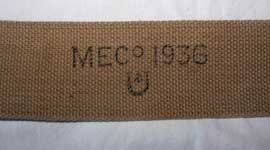 These were the standard reduction-woven type, first seen on Patt. ’13 W.E. and latterly on Patt. ’37 W.E. They were qualified as “…without buckle…”, since the Large pack had integrated shoulder straps. Although D.D. 409 S.A. simply lists “…Braces…”, the No. 3 Pattern had handed Braces, the left one having a cross-over loop for the right Brace to pass through. The U.D.F. version had the same and, although there were four available Brace ends, no equipment was provided that needed attaching to these. Both Braces are maker marked "M .E. Co." and dated 1936.
These were the standard reduction-woven type, first seen on Patt. ’13 W.E. and latterly on Patt. ’37 W.E. They were qualified as “…without buckle…”, since the Large pack had integrated shoulder straps. Although D.D. 409 S.A. simply lists “…Braces…”, the No. 3 Pattern had handed Braces, the left one having a cross-over loop for the right Brace to pass through. The U.D.F. version had the same and, although there were four available Brace ends, no equipment was provided that needed attaching to these. Both Braces are maker marked "M .E. Co." and dated 1936.
CARRIERS, CARTRIDGE, LEFT and RIGHT
Patroontassies, linkersy en regtersy
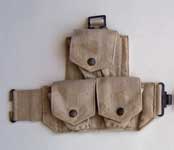
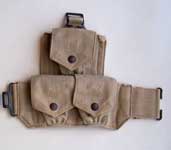 This is the form illustrated, both by Lethern and in South African Army photographs. An integrally woven pair of pockets had a third pocket stitched symmetrically to the top edge. The flaps secure by press studs on each flap, with a Guard Strap folded under the flap, as with Patt. ’40 W.E. Cartridge Carriers. The re-curved 4-bar Brace buckle was set closer to the Carrier than on earlier trials forms. This is because the Patt. ’25 type differential 2 inch / 1 inch brass double loop had been discarded. Instead, the buckle was attached directly to a waisted and doubled chape, which formed a fairlead for the Brace to pass through and behind the Carrier. This feature would be repeated on Patt. ’37 Basic pouches. Internally, the pockets were divided by an integrally woven partition, splitting the pocket into an asymmetric arrangement. Two chargers fitted in front of the partition, with only one behind. Each Carrier could therefore carry nine chargers of .303-in. ammunition. The left hand Cartridge carrier carried the loop part of a “Hook and loop” buckle. The other Carrier had the hook element and both Carriers, at their rearward ends, had an extension with a “C” clip to engage with a Strap, back adjustment. The buckle and “C” clips were of 2.25-in. strap accommodation.
This is the form illustrated, both by Lethern and in South African Army photographs. An integrally woven pair of pockets had a third pocket stitched symmetrically to the top edge. The flaps secure by press studs on each flap, with a Guard Strap folded under the flap, as with Patt. ’40 W.E. Cartridge Carriers. The re-curved 4-bar Brace buckle was set closer to the Carrier than on earlier trials forms. This is because the Patt. ’25 type differential 2 inch / 1 inch brass double loop had been discarded. Instead, the buckle was attached directly to a waisted and doubled chape, which formed a fairlead for the Brace to pass through and behind the Carrier. This feature would be repeated on Patt. ’37 Basic pouches. Internally, the pockets were divided by an integrally woven partition, splitting the pocket into an asymmetric arrangement. Two chargers fitted in front of the partition, with only one behind. Each Carrier could therefore carry nine chargers of .303-in. ammunition. The left hand Cartridge carrier carried the loop part of a “Hook and loop” buckle. The other Carrier had the hook element and both Carriers, at their rearward ends, had an extension with a “C” clip to engage with a Strap, back adjustment. The buckle and “C” clips were of 2.25-in. strap accommodation.
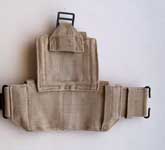
 Inside views of the same pair of Carriers. Note the simplified attachment of the upper buckle, when compared to that of W.E. Patt. '25. This same design would be carried forward and used in W.E. Cavalry Patt. '40.
Inside views of the same pair of Carriers. Note the simplified attachment of the upper buckle, when compared to that of W.E. Patt. '25. This same design would be carried forward and used in W.E. Cavalry Patt. '40.

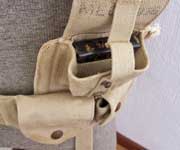
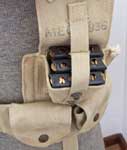 Detail views of a cartridge pocket, showing the unique interior arrangement. Instead of the usual three interior compartments, these pockets only have two, the front one sized for two chargers.
Detail views of a cartridge pocket, showing the unique interior arrangement. Instead of the usual three interior compartments, these pockets only have two, the front one sized for two chargers.
FROG, BAYONET
Lissies, bajonet


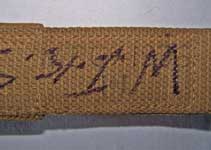 This was the narrower form, which was employed in Patts. 1913, 1919 and 1925 and which would re-appear as a Patt. 1937 W.E. component. No mention was made of a press stud to locate the Frog, as with Patt. 1919 W.E. Rifle Equipment and Patt. 1925 W.E. Although it's difficult to see in the picture, this Frog is maker marked "M .E. Co." and dated 1936.
This was the narrower form, which was employed in Patts. 1913, 1919 and 1925 and which would re-appear as a Patt. 1937 W.E. component. No mention was made of a press stud to locate the Frog, as with Patt. 1919 W.E. Rifle Equipment and Patt. 1925 W.E. Although it's difficult to see in the picture, this Frog is maker marked "M .E. Co." and dated 1936.
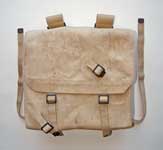
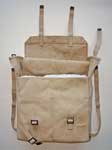
 The Rucksack forming part of No. 3, in essence, is the Patt. ’25 “Two Part” Pack, but with altered proportions of Upper and Lower Parts, which Mills termed Rucksack-Pack and Pack, respectively. The upper is half as deep again as Pn. ’25, with the lower part only half the depth of Pn. ’25. Thus, overall, it is the same total height as the Pn. ’25 combination. It had integrated shoulder straps, adjustable through fixed 2-inch buckles on the top edge. As with Patt. ’25 W.E., these straps had Hooks, haversack to link to the 4-bar buckles on the Cartridge carriers, though here both counter straps (underarm) were permanently attached to the hooks. The example shown in this pictures is maker marked "M .E. Co." and dated 1936.
The Rucksack forming part of No. 3, in essence, is the Patt. ’25 “Two Part” Pack, but with altered proportions of Upper and Lower Parts, which Mills termed Rucksack-Pack and Pack, respectively. The upper is half as deep again as Pn. ’25, with the lower part only half the depth of Pn. ’25. Thus, overall, it is the same total height as the Pn. ’25 combination. It had integrated shoulder straps, adjustable through fixed 2-inch buckles on the top edge. As with Patt. ’25 W.E., these straps had Hooks, haversack to link to the 4-bar buckles on the Cartridge carriers, though here both counter straps (underarm) were permanently attached to the hooks. The example shown in this pictures is maker marked "M .E. Co." and dated 1936.
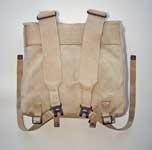
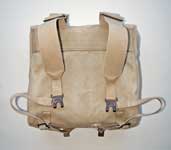
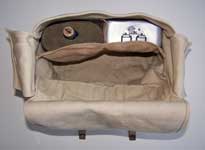 In South African use, these were respectively termed Large pack and Small pack. The Large pack had an internal partition, which divided the Large pack from side-to-side. A second partition joined the centre one to the front wall of the Pack, thus forming three compartments. The Bottle, water, enamelled, Mark VI was to be carried in one front compartment, an aluminium Mess tin in the other. This feature would re-appear in the smaller Patt. ’37 Haversack, used in the same way.
In South African use, these were respectively termed Large pack and Small pack. The Large pack had an internal partition, which divided the Large pack from side-to-side. A second partition joined the centre one to the front wall of the Pack, thus forming three compartments. The Bottle, water, enamelled, Mark VI was to be carried in one front compartment, an aluminium Mess tin in the other. This feature would re-appear in the smaller Patt. ’37 Haversack, used in the same way.
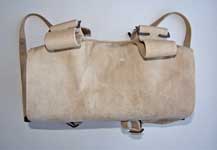
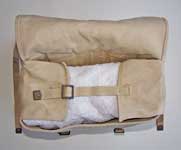 The flap and body of the Upper rucksack in No. 3 Pattern were each fitted with short straps, the pair then being on a diagonal alignment. A new Entrenching tool had been selected for use with No. 3 Equipment. This was a short, T-handled spade, with a pointed pan, in form and size much as a child’s beach spade, but of far more substantial construction. The right-hand tread was extended into a chisel pointed pick. The U.D.F. did not adopt this tool, though the Large pack was still fitted with these straps. An E.T. does not appear in D.D. 409 S.A., though in the British Army, such tools were separately catalogued from accoutrements. The Sirhind tool appears not to have been in service either (it had been made obsolete in the British Army in 1923), so the D.D. 409 S.A. listing for Patt. ’08 does not include Carriers for either Head, or Helve. John Lamont has observed that the terrain of South Africa is so hard, that it warrants proper picks and shovels and not an Entrenching tool, per se. The base of the Pack was fitted with a pair of ¾-in. buckles on chapes angled outwards, to which the counter strap of each shoulders strap were attached. Unusually, the flaps of both Packs were secured by straps and ¾-in. buckles, not the usual 1-in. straps and buckles.
The flap and body of the Upper rucksack in No. 3 Pattern were each fitted with short straps, the pair then being on a diagonal alignment. A new Entrenching tool had been selected for use with No. 3 Equipment. This was a short, T-handled spade, with a pointed pan, in form and size much as a child’s beach spade, but of far more substantial construction. The right-hand tread was extended into a chisel pointed pick. The U.D.F. did not adopt this tool, though the Large pack was still fitted with these straps. An E.T. does not appear in D.D. 409 S.A., though in the British Army, such tools were separately catalogued from accoutrements. The Sirhind tool appears not to have been in service either (it had been made obsolete in the British Army in 1923), so the D.D. 409 S.A. listing for Patt. ’08 does not include Carriers for either Head, or Helve. John Lamont has observed that the terrain of South Africa is so hard, that it warrants proper picks and shovels and not an Entrenching tool, per se. The base of the Pack was fitted with a pair of ¾-in. buckles on chapes angled outwards, to which the counter strap of each shoulders strap were attached. Unusually, the flaps of both Packs were secured by straps and ¾-in. buckles, not the usual 1-in. straps and buckles.
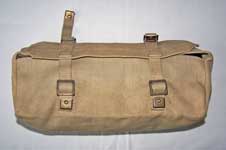
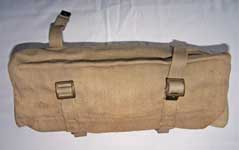
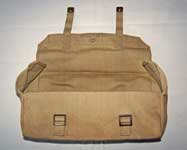 Usually distributed between Pack and Haversack, the Holdall, towel, soap, housewife, oil bottle and socks were instead carried in the Small pack in the No. 3 Model. The Iron Ration went in the Upper rucksack, with the un-consumed portion of the day’s ration probably carried in the Tins, mess, rectangular, aluminium. This is the U.K. nomenclature, the U.D.F. equivalent being unknown. In D.D. 409 S.A., Tins, mess (Eetblikke) may be the old D-section Tins, mess, D.S. and not the rectangular type, which dated from at least 1936 for the U.D.F. The pictures at left show the front face of the Small pack, in open and closed positions. The example shown in this pictures is maker marked "M .E. Co." and dated 1936.
Usually distributed between Pack and Haversack, the Holdall, towel, soap, housewife, oil bottle and socks were instead carried in the Small pack in the No. 3 Model. The Iron Ration went in the Upper rucksack, with the un-consumed portion of the day’s ration probably carried in the Tins, mess, rectangular, aluminium. This is the U.K. nomenclature, the U.D.F. equivalent being unknown. In D.D. 409 S.A., Tins, mess (Eetblikke) may be the old D-section Tins, mess, D.S. and not the rectangular type, which dated from at least 1936 for the U.D.F. The pictures at left show the front face of the Small pack, in open and closed positions. The example shown in this pictures is maker marked "M .E. Co." and dated 1936.
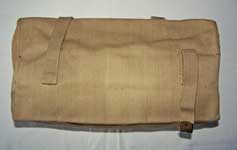

 The rear face of the Small pack carried two vertically aligned ¾-in. straps, which mated to the base buckles of the Large pack. The flap on the Small pack was closed by similar ¾-in. straps, stitched to the underside of the flap, as was normal in Mills’ products. On the outside of the flap there were two ¾-in. buckles, on short straps. These were superimposed over and stitched through the fixed ends of the flap strap. Two angled base buckles allowed for attachment of the Large pack’s shoulder straps, when both Packs were assembled together. Weather flaps were fitted, but stitched at the rear to the main flap, forming a semi-gusseted flap. This detail can be seen in the photo at near left. Far left, the rear face of the Small pack.
The rear face of the Small pack carried two vertically aligned ¾-in. straps, which mated to the base buckles of the Large pack. The flap on the Small pack was closed by similar ¾-in. straps, stitched to the underside of the flap, as was normal in Mills’ products. On the outside of the flap there were two ¾-in. buckles, on short straps. These were superimposed over and stitched through the fixed ends of the flap strap. Two angled base buckles allowed for attachment of the Large pack’s shoulder straps, when both Packs were assembled together. Weather flaps were fitted, but stitched at the rear to the main flap, forming a semi-gusseted flap. This detail can be seen in the photo at near left. Far left, the rear face of the Small pack.
CONNECTING LARGE AND SMALL PACKS
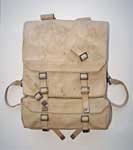

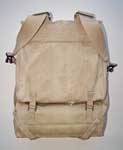 The methodology differed slightly from that used in Patt. ’25, though it used identical ¾-in. base buckles, on loose chapes near the rear face of the Large pack. These were connected to corresponding straps on the Small pack. This was done in such a way as to leave the running ends sandwiched between the Large pack’s base and Small pack’s top surface and ensured the buckle did not dig into the wearer’s back. The connection on the front faces was very different to Patt. ’25. The buckles on the Small pack’s front face were attached to the running ends of the Large pack’s flap straps. U.D.F. photos, so far noted, all show parades and, not being “in the field”, the Small pack is not being worn. Can any South African reader improve on this?
The methodology differed slightly from that used in Patt. ’25, though it used identical ¾-in. base buckles, on loose chapes near the rear face of the Large pack. These were connected to corresponding straps on the Small pack. This was done in such a way as to leave the running ends sandwiched between the Large pack’s base and Small pack’s top surface and ensured the buckle did not dig into the wearer’s back. The connection on the front faces was very different to Patt. ’25. The buckles on the Small pack’s front face were attached to the running ends of the Large pack’s flap straps. U.D.F. photos, so far noted, all show parades and, not being “in the field”, the Small pack is not being worn. Can any South African reader improve on this?
 Access to either Pack was therefore made more difficult than was strictly necessary – all to achieve a Battle Order, whereby the Small pack was discarded. On John Lamont’s example, the base buckles of the Small pack have been removed. Whilst the two Packs could still be connected, they cannot be worn, since the Large pack’s base buckles are required for the counter strap. What appears to have happened is that the Small pack has been made into a “kidney pouch”, its external straps and buckles being connected, forming loops through which the Back adjustment strap can be passed. This allowed the Small pack to be opened, whilst still being retained on the Back adjustment strap. Whether this was an official modification, or a soldier’s field mod is not known.John has just discovered two small web loops, shown in the picture at left in what appears to be their correct place on the bottom of his Small pack. If he determines that these are, in fact, the missing tabs for the base buckles, he intends to add the correct buckle fittings and complete his Small pack as it was originally constructed.
Access to either Pack was therefore made more difficult than was strictly necessary – all to achieve a Battle Order, whereby the Small pack was discarded. On John Lamont’s example, the base buckles of the Small pack have been removed. Whilst the two Packs could still be connected, they cannot be worn, since the Large pack’s base buckles are required for the counter strap. What appears to have happened is that the Small pack has been made into a “kidney pouch”, its external straps and buckles being connected, forming loops through which the Back adjustment strap can be passed. This allowed the Small pack to be opened, whilst still being retained on the Back adjustment strap. Whether this was an official modification, or a soldier’s field mod is not known.John has just discovered two small web loops, shown in the picture at left in what appears to be their correct place on the bottom of his Small pack. If he determines that these are, in fact, the missing tabs for the base buckles, he intends to add the correct buckle fittings and complete his Small pack as it was originally constructed.
STRAP, BACK ADJUSTMENT
Verstelbare rugbande

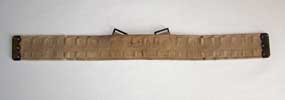 This was identical to that used with the naval version of Patt. ’19 W.E. and served to form a “belt” when connected to the “C” clips on the rear ends of the Cartridge carriers. The outside had the usual angled chapes, with 1-inch buckles, for the rear ends of the Braces. As with naval Patt. ’19, but unlike Patt. '19 Rifle Equipment and Patt. ’25, no male press stud halves were fitted.
This was identical to that used with the naval version of Patt. ’19 W.E. and served to form a “belt” when connected to the “C” clips on the rear ends of the Cartridge carriers. The outside had the usual angled chapes, with 1-inch buckles, for the rear ends of the Braces. As with naval Patt. ’19, but unlike Patt. '19 Rifle Equipment and Patt. ’25, no male press stud halves were fitted.
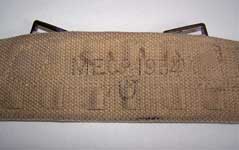 A detail of the inside, showing the markings. It is maker marked "M .E. Co." and dated 1934.
A detail of the inside, showing the markings. It is maker marked "M .E. Co." and dated 1934.

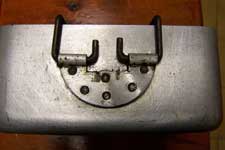
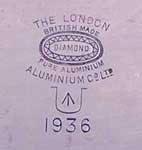 Although not part of Web Equipment, Braithwaite, this example of the South African Mess Tin is included here as an associated item. Only this single example of a U.D.F. Tin is known, but it seems logical, given its form, that it was a nested pair, similar to the Mess tin which would later enter service with the British Army. This Tin is maker marked "The London Aluminium Co. Ltd." and dated 1936.
Although not part of Web Equipment, Braithwaite, this example of the South African Mess Tin is included here as an associated item. Only this single example of a U.D.F. Tin is known, but it seems logical, given its form, that it was a nested pair, similar to the Mess tin which would later enter service with the British Army. This Tin is maker marked "The London Aluminium Co. Ltd." and dated 1936.
Conclusions
The above are the sum total of Braithwaite Web Equipment. At just eight components, it makes it the smallest full Pattern that Mills ever produced and one of the least-known. Karkee Web is indeed fortunate that John Lamont was able to respond to my request for information on the website for Southern Africa Arms and Ammunition Collectors Association (S.A.A.A.C.A.) http://www.saaaca.org.za. At the time, John lacked the Frog for this set, but in the intervening time was able to rectify this shortfall and complete his set.
The exact nomenclature was established through one document, D.D. 409 S.A., so it is even more fortunate that John’s late father preserved this important piece of paper. Although he only ever wore, firstly, Patt. ’08 and then Patt. ’37, it is appropriate to include a little of L/Cpl G.F. Lamont’s war.
Rog Dennis
January, 2010